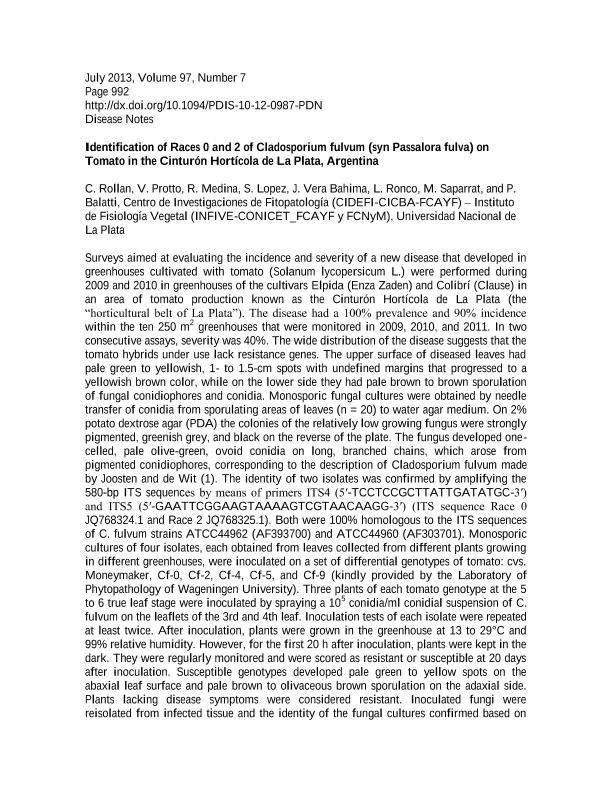Artículo
Identification of Races 0 and 2 of Cladosporium fulvum (syn Passalora fulva) on Tomato in the Cinturón Hortícola de La Plata, Argentina
Rollan, Cristina; Protto, V; Medina, Rocio ; López, Silvina Marianela Yanil
; López, Silvina Marianela Yanil ; Vera Bahima, José
; Vera Bahima, José ; Ronco, Blanca L.; Saparrat, Mario Carlos Nazareno
; Ronco, Blanca L.; Saparrat, Mario Carlos Nazareno ; Balatti, Pedro Alberto
; Balatti, Pedro Alberto
 ; López, Silvina Marianela Yanil
; López, Silvina Marianela Yanil ; Vera Bahima, José
; Vera Bahima, José ; Ronco, Blanca L.; Saparrat, Mario Carlos Nazareno
; Ronco, Blanca L.; Saparrat, Mario Carlos Nazareno ; Balatti, Pedro Alberto
; Balatti, Pedro Alberto
Fecha de publicación:
07/2013
Editorial:
American Phytopathological Society
Revista:
Plant Disease
ISSN:
0191-2917
Idioma:
Inglés
Tipo de recurso:
Artículo publicado
Clasificación temática:
Resumen
Surveys aimed at evaluating the incidence and severity of a new disease that developed in greenhouses cultivated with tomato (Solanum lycopersicum L.) were performed during 2009 and 2010 in greenhouses of the cultivars Elpida (Enza Zaden) and Colibrí (Clause) in an area of tomato production known as the Cinturón Hortícola de La Plata (the “horticultural belt of La Plata”). The disease had a 100% prevalence and 90% incidence within the ten 250 m2 greenhouses that were monitored in 2009, 2010, and 2011. In two consecutive assays, severity was 40%. The wide distribution of the disease suggests that the tomato hybrids under use lack resistance genes. The upper surface of diseased leaves had pale green to yellowish, 1- to 1.5-cm spots with undefined margins that progressed to a yellowish brown color, while on the lower side they had pale brown to brown sporulation of fungal conidiophores and conidia. Monosporic fungal cultures were obtained by needle transfer of conidia from sporulating areas of leaves (n = 20) to water agar medium. On 2% potato dextrose agar (PDA) the colonies of the relatively low growing fungus were strongly pigmented, greenish grey, and black on the reverse of the plate. The fungus developed one-celled, pale olive-green, ovoid conidia on long, branched chains, which arose from pigmented conidiophores, corresponding to the description of Cladosporium fulvum made by Joosten and de Wit (1). The identity of two isolates was confirmed by amplifying the 580-bp ITS sequences by means of primers ITS4 (5′-TCCTCCGCTTATTGATATGC-3′) and ITS5 (5′-GAATTCGGAAGTAAAAGTCGTAACAAGG-3′) (ITS sequence Race 0 JQ768324.1 and Race 2 JQ768325.1). Both were 100% homologous to the ITS sequences of C. fulvum strains ATCC44962 (AF393700) and ATCC44960 (AF303701). Monosporic cultures of four isolates, each obtained from leaves collected from different plants growing in different greenhouses, were inoculated on a set of differential genotypes of tomato: cvs. Moneymaker, Cf-0, Cf-2, Cf-4, Cf-5, and Cf-9 (kindly provided by the Laboratory of Phytopathology of Wageningen University). Three plants of each tomato genotype at the 5 to 6 true leaf stage were inoculated by spraying a 105 conidia/ml conidial suspension of C. fulvum on the leaflets of the 3rd and 4th leaf. Inoculation tests of each isolate were repeated at least twice. After inoculation, plants were grown in the greenhouse at 13 to 29°C and 99% relative humidity. However, for the first 20 h after inoculation, plants were kept in the dark. They were regularly monitored and were scored as resistant or susceptible at 20 days after inoculation. Susceptible genotypes developed pale green to yellow spots on the abaxial leaf surface and pale brown to olivaceous brown sporulation on the adaxial side. Plants lacking disease symptoms were considered resistant. Inoculated fungi were reisolated from infected tissue and the identity of the fungal cultures confirmed based on morphology and the ITS sequence. Based on the reactions of the tomato genotypes, two races were identified, three isolates (race 2) developed symptoms only in cv. MM Cf-2, while the remaining isolate (race 0) provoked symptoms only in cv. MM Cf-0.
Palabras clave:
Races 0 And 2
,
Cladosporium Fulvum
,
Tomato
,
Cinturón Hortícola de La Plata
Archivos asociados
Licencia
Identificadores
Colecciones
Articulos(CCT - LA PLATA)
Articulos de CTRO.CIENTIFICO TECNOL.CONICET - LA PLATA
Articulos de CTRO.CIENTIFICO TECNOL.CONICET - LA PLATA
Citación
Rollan, Cristina; Protto, V; Medina, Rocio; López, Silvina Marianela Yanil; Vera Bahima, José; et al.; Identification of Races 0 and 2 of Cladosporium fulvum (syn Passalora fulva) on Tomato in the Cinturón Hortícola de La Plata, Argentina; American Phytopathological Society; Plant Disease; 97; 7; 7-2013; 992
Compartir
Altmétricas



